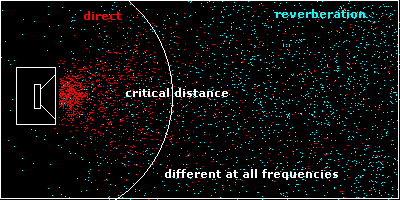 | ||
Tom demac critical distance pt 2 official video
Critical distance is, in acoustics, the distance at which the sound pressure level of the direct sound D and the reverberant sound R are equal when dealing with a directional source. In other words, the point in space where the combined amplitude of all the reflected echoes are the same as the amplitude of the sound coming directly from the source (D = R). This distance, called the critical distance
Contents
In a reverberant space, the sound perceived by a listener is a combination of direct and reverberant sound. The ratio of direct sound is dependent on the distance between the source and the listener, and upon the reverberation time in [the room]. At a certain distance the two will be equal. This is called the "critical distance."
A reverberant room generates a short critical distance and an acoustically dead (anechoic) room generates a longer critical distance.
Maybeshewill critical distance
Calculation
The calculation of the critical distance for a diffuse approximation of the reverberant field:
where
